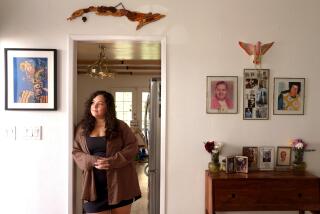Model Car Makers Get Skills in Shape for Scarce Trainee Jobs
- Share via
NEWPORT BEACH — John Grimes had never made anything much bigger than an ashtray in ceramics class, but there he stood, digging clay from beneath his nails and examining the lines of the full-size automobile model he’d been carving on all week.
Grimes, an 18-year-old Fountain Valley High School graduate, is one of eight candidates for a trainee job in one of the most exclusive trades in the automotive business--a model maker.
The candidates are evaluated during three-week programs run periodically at Calty Design Research, Toyota Motor Co.’s key North American research and design studio.
And although only one or two of the candidates are likely to be offered a job--a decision Calty officials are expected to make later this week--there aren’t any losers, they say. The program has given Grimes and his classmates a taste of a career path few people know exists: translating the sometimes otherworldly musings of automobile designers into three-dimensional realities.
“I didn’t know you could get paid to make car models,” said Reuben Chavez, also 18 and a June graduate of Los Alamitos High School.
*
But you can--if your fingers can breathe life into clay. Trainee modelers start at about $500 a week, but top model makers command salaries of $80,000 or more a year. There probably are no more than two dozen job openings a year, though, and just getting trained is difficult.
They don’t teach model making at the local community college, and even rigorous programs such as the prestigious transportation design schools at Art Center College of Design in Pasadena offer only a few hours of model making training to students striving to win designer credentials.
Calty runs its program when it needs a new trainee--there have been six courses in the last eight years, including two this year. A third of the 30 candidates who have been through the program are working as modelers.
“We used to be like all the other studios, dependent on hiring people who’d been trained in Michigan,” said David Hackett, Calty studio director.
“But we got people who’d come here and just couldn’t handle the culture shock or the price of housing, so we decided to bite the bullet and hire people who already lived here. And that meant doing our own training.”
The models turned out in auto design studios are crafted from the ground up. Although models of clay spread over steel or wooden frames are most common, modelers also learn to use fiberglass, plastics and foam.
The finished products, hand-smoothed into complex shapes and coated with special paints that replicate the gleam of enamel on metal, are just a part of the long, complex process that leads from the drawing table to the showroom floor.
But they are an essential part, enabling designers to finally see what had existed only in their minds and providing marketing executives, manufacturing engineers and focus groups something tangible to work with.
*
Modelers take the drawings from the designer’s table and build three-dimensional representations of the car. Trainees do it exactly as drawn, while more advanced modelers become a part of the design team, telling the designer what works and what doesn’t, suggesting subtle alterations in line and shape that make the vehicle even more pleasing to the eye.
In some of the largest studios, sophisticated computer modeling software enables designers to develop and refine their work in 3-D right on the computer screen. But modelers and designers say that computers will never put human modelers out of business.
“We’re the 3-D masters,” said Lanny Zamora, an advanced model maker at the secluded Newport Beach studio. “We can tell them what’s possible and what’s not possible and why something that looked good on paper just doesn’t work. A lot of times, the designer just doesn’t understand that until we move some clay around and show them.”
Like auto design, model making is a profession that so far seems to appeal more to males, although the industry has come to realize that with women making more than half the nation’s car-buying decisions, a woman’s sensibilities in the design studio are an asset.
Only one of the 14 prospects for the Calty summer class was a woman, and she wasn’t picked for the program. To date, only one woman has been accepted in the Calty program. Although she wasn’t hired by the studio, she was able to use the experience to help land a modeler trainee job with a competitor, said Zoe Sessler, Calty’s human relations director.
In the past, most of the Calty modeler candidates have come out of art and automotive programs at area community colleges and trade schools. This year, though, the studio sought June high school graduates as well after joining the Orange County Vital Link program. The business and education partnership program “helps prepare kids for trades and careers that don’t require college,” Sessler said.
This group of candidates ranged in age from 17 to 24.
*
Studio chief Hackett said the program has been invaluable. Of the dozen modelers now working at Calty, seven were picked from the studio’s training classes.
Zamora and fellow modeler David Roberts--both instructors in the summer session--came from Calty’s initial introductory class in 1988.
Zamora, a 29-year-old Brea resident, ran the middle part of the course this summer, a week in which each student built a wood-and-foam form for a small-scale model, covered it with clay and then, using modeling tools and handmade templates, coaxed the basic shape of a modern automobile out of the red lump.
The third week was devoted to work on a full-size model: each student working on a different part of the project each day.
“It’s been quite an experience,” said Gustavo Perez, 21, a student at Cypress College’s auto body technician program and a longtime car buff.
“It’s completely different from bodywork. When you’re working with metal, it shows you what it was, and all you’ve got to do is get it back into shape by fixing the bent parts. With modeling, you start with nothing but a drawing. You’ve got to be able to see what the clay will be and then make it be that.”
(BEGIN TEXT OF INFOBOX / INFOGRAPHIC)
From Concept to Showroom Five design groups compete to come up with a design for Toyota’s future lineup. The process can take from three to five years from idea to production. One group, Calty Design Research, is in Newport Beach. How Toyota brings a new car to market: Developing Ideas * Design groups are given specific demographic groups to target when designing vehicles. * Designers share sketches with other designers for input. * Sketches are made into 2-D and 3-D computer renderings. Making Models * Three to five concepts are made as one-fifth-scale models. Models are made by applying clay over a steel and urethane framework. The model is painted, then fabricated headlights, taillights and other features are applied. * The winning design is made into a full-size model. Reviewing Concepts * The model is shipped to Japan for design competition and review by various committees and upper management. Testing Designs * The approved design is subjected to intense engineering studies. Styling changes are made to accommodate engineering requirements. * An operational car is produced and tested for noise, vibration, road handling and performance. Numerous reconfigured prototypes are made and tested. Producing Cars * The car is produced and marketed. Source: Calty Design Research; researched by JANICE L. JONES/Los Angeles Times *






